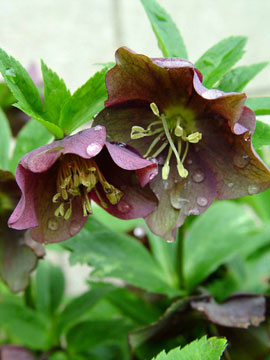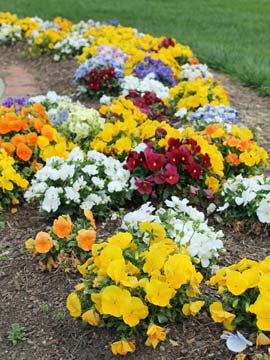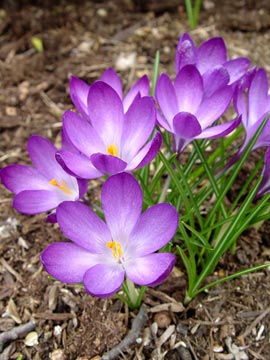Most flowers strut their stuff in the balmy days of spring and summer when the words "killing frost" and “snow squall" are distant memories. But a few feisty varieties have the moxie to flower even before winter is done, or in the case of warm Southern and Southwestern states, during winter. These cold-tolerant early-starters make good additions to the landscape because they have the good sense to bloom when little else is going on and when color is most appreciated.
 Lenten rose is one of the earliest perennials to bloom, often when it’s still winter.
Lenten rose is one of the earliest perennials to bloom, often when it’s still winter.
© George Weigel
Here are eight of the season’s earliest-blooming flowers to help get your yard off to a good start:
1. Snowdrops (Galanthus nivalis). These are the earliest of the spring-blooming bulbs, often poking out above the snow as early as January or February, even in the Northeast and Midwest.
Snowdrop flowers have three white petals that hang down like milk drops dripping off the stems. Plants grow only about 4 to 6 inches tall. Plant the pea-sized bulbs 4 to 6 inches apart in fall, and fertilize them each spring and fall. Then watch them bloom year after year for a few weeks each winter (Zones 2-9).
2. Lenten or Christmas rose (Helleborus). These aren’t roses at all but foot-tall evergreen perennials that produce winter flowers that look a bit like old roses. Christmas rose (Helleborus niger) is usually the season’s first-to-bloom perennial, opening its five-petaled white flowers in January in the South and early March in the North(Zones 3-8). Lenten rose (Helleborus orientalis and x hybridus) blooms a few weeks later and has more nodding, bell-shaped flowers of pink, rose or white (Zones 4-9). Both prefer afternoon shade and make excellent groundcovers under trees. Fertilize each spring.
 Pansies are some of the cold-hardiest annuals and will overwinter throughout most of the United States.
Pansies are some of the cold-hardiest annuals and will overwinter throughout most of the United States.
© George Weigel
3. Pansy (Viola × wittrockiana). Southerners grow masses of multi-colored pansies for all-winter color, while Northerners can plant them in early spring or in fall. Fall-planted ones usually overwinter in all but the coldest parts of the United States, then resume flowering as soon as snow melts at winter’s end. Pansies are short (6-inch), compact plants that produce rounded flowers of overlapping little fans. They come in a wide variety of colors. Pansies grow best in cool weather (45 to 65 degrees) and usually shut down flowering and/or shrivel in summer’s heat. Fertilize them at planting and again in early spring for fall-planted ones (Zones 4-11).
4. Violets (Viola species). Closely related to pansies, violets are also usually grown as cool-season annuals. They’ll tolerate freezes and overwinter as low as Zone 4. But as with pansies, they fade when heat arrives. Violet flowers are usually slightly smaller than pansy flowers, and their flower shapes are slightly different. Pansies have four petals that point up and one that points down, while violets have three petals that point up and two that point down. Fertilize violets at planting and again in spring for fall-planted ones (Zones 4-11).
5. Snapdragon (Antirrhinum majus). A third cool-season annual is the snapdragon, which blooms on spiky, 1- to 2-foot-tall stems – mostly in "warm" colors such as red, gold and hot pink. These aren’t quite as cold-tolerant as pansies and violas for fall planting in the North, but they can flower all winter in the South and tolerate enough frostiness for early-spring Northern planting. Fertilize at planting and about 6 weeks later. Snip off browned flower stalks, and you may find snapdragons survive most summers to perk up again in fall (Perennial in Zones 9-11).
6. Reticulated iris (Iris reticulata). This earliest of the irises blooms in late winter, most often in blue, purple, gold or blends of those, depending on variety. The flowers look like small bearded-iris flowers with their drooping petals, but the plants are much smaller, growing only about 4 to 6 inches tall.
 Crocus 'Ruby Giant' in flower in March.
Crocus 'Ruby Giant' in flower in March.
© George Weigel
Plant reticulated iris as bulbs in fall, and fertilize them each spring and fall. They’ll die back to the ground for the season by late spring (Zones 5-9).
7. Crocus (Crocus species). Also a spring-blooming bulb that’s planted in fall, crocus flowers in late winter, around the same time as the above reticulated iris. Plants grow only about 4 inches tall and produce upward-facing, bell-shaped flowers in a wide variety of colors. The fine, grassy foliage dies back to the ground by late spring with no cutting necessary. Fertilize each spring and fall. (Zones 3-8).
8. Winter jasmine (Jasminum nudiflorum). This woody, perennial vine produces yellow flowers all along its stems in late winter. It’s different from the white-flowering jasmine, and it isn’t fragrant as that one. Prune back the stems after flowering if the plant is getting too rangy, and fertilize it in spring (Zones 6-10).